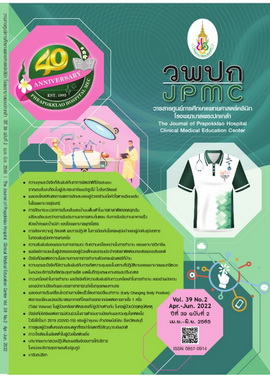Knowledge, Attitude and Practice Regarding Rabies Prevention in a Military Working Dog Battalion
Main Article Content
Abstract
BACKGROUND: Soldiers in a military working dog battalion both train dogs and experience a high occupational risk of dog bites; thus, they are at a higher risk of contracting rabies.
OBJECTIVE: This study aimed to determine the knowledge, attitude, and practice (KAP) regarding rabies prevention among soldiers in a military working dog battalion.
METHODS: This study employed a cross-sectional design with 124 participants and used a questionnaire provided by the Department of Disease Control. Descriptive statistics using numbers and percentages were applied in general and then classified by population characteristics. Fisher’s exact test was used to investigate the association between population characteristics to prevent rabies by total score.
RESULTS: Most of the sample group answered that washing dog bite wounds with water and soap and then applying Betadine to the infection site can reduce Infection (77.4%). Other responses included that puppies need to be vaccinated (75.8%) and that all mammals can be rabid (70.2%). The population characteristics that showed an excellent score were those of the respondents with a Undergraduate or above education (47.8%), and those who were studying the military working dog battalion training program (54.8%). The study revealed several factors associated with the prevention of contracting rabies, including having participated in military dog training programs, having previous employment working with dogs, and being experienced in taking care of personal dogs and cats.
CONCLUSIONS: This study found that KAP and guidelines to prevent rabies, based on the evidence, should be used to develop a policy to prevent members of military dog battalions from contracting rabies.
Article Details

This work is licensed under a Creative Commons Attribution-NonCommercial-NoDerivatives 4.0 International License.
References
Fook AR, Cliquets F, Finke S, Freulling C, Hemachudha T, Mani R, et al. Rabies. Nat Rev Dis Primers [Internet]. 2017[cited 2021 Mar 19];3:17091. Available from: https://www.nature.com/articles/nrdp201791.pdf
Sirimalaisuwan A. Zoonosis. Chiang Mai: Sombhon Publishing;2018.
Duron S, Ertzscheid C, de Laval F, Manet G, Ficko C, Velut G,et al. Public health investigation in a military cAMP after diagnosis of rabies in a dog-Afghanistan, 2012.J Travel Med 2014;21:58-61.
Ministry of Public Health. Strategic plan of zero rabies project 2017-2020 under Her Royal Highness Princess Chulabhorn Mahidol project 2017-2020. Nonthaburi: Division of communicable diseases; 2017.
Division of communicable Disease. Rabies and dog bite questionnaire [Internet]2012 [cited 2021 Mar 19].Available from: http://r36.ddc.moph.go.th/r36/document/view/17/238.
Matibag GC, Kamigaki T, Kumarasiri PV, Wijewardana TG, Kalupahana AW, Dissanayake DR, et al. Knowledge, attitudes, and practices survey of rabies in a community in Sri Lanka. Environ Health Prev Med 2007;12:84-9.
Davlin SL, Lapiz SM, Miranda ME, Murray KO. Knowledge, attitudes, and practices regarding rabies in Filipinos following implementation of the Bohol Rabies prevention and elimination programme. Epidemiol Infect 2014;142:1476-85.
SagarasearaneeO,Hinjoy S, Chuxnum T, Chantean T,SmithsuwanP, Jorhor N,et al. Survey of knowledge, attitude, and practice initiated by an investigation of a human rabies death in Chanthaburi province, Thailand, 2015.OSIR 2017: 10(3); 1-8.
Rakpanit S, Vaeteewootacharn K. Factors associated with dog owner’s behavior on rabies prevention in Muang District, Buriram province.Journal of Nursing and Health Care 2018; 36(2):158-66.
Ntampaka P, Nyaga PN, Niragire F, Gathumbi JK, Tukei M. Knowledge, attitudes and practices egarding rabies and its control among dog owners in Kigali city, Rwanda. PLoS One [Internet]. 2019[ cited 2021 Oct 21];14(8):e0210044. Available from: https://journals.plos.org/plosone/article/file?id=10.1371/journal.pone.0210044&type=printable
Sambo M, Lembo T, Cleaveland S, Ferguson HM, Sikana L, Simon C, et al. Knowledge, attitudes and practices (KAP) about rabies prevention and control: a community survey in Tanzania. PLoS Negl Trop Dis [Internet]. 2014[cited 2021 Oct 21] 4;8(12):e3310. Available from: https://journals.plos.org/plosntds/article/file?id=10.1371/journal.pntd.0003310&type=printable
